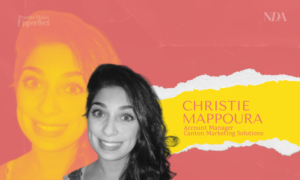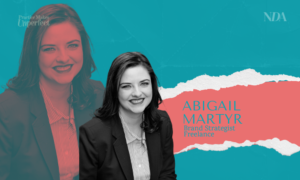These articles have been written by the first cohort of the Practice Makes Unperfect programme – a course that helps women find and finesse their public voices.
Zoe Bruton, Agency Account Manager at A Million Ads.
Data-driven advertising is trendy, which is a blessing and a curse. If ever I pitch a (very good) idea and there’s one unconvinced stakeholder, I give a quick reassurance that the creative strategy is based on data insights and – as if like magic – we’re onto a winner.
It’s like a greyscale idea becomes brighter when numbers are mentioned. Like many trends, the more people that adopt it, the more appropriations we see. Sometimes the outcome of an adopted trend can be far removed from its initial iteration. Sometimes we forget the first iteration entirely, and switch to a colourful narrative instead.
Sometimes we claim that our work has been driven by data… but was it actually?
A report by Kantar in 2019 showed that 47% of advertisers still aren’t comfortable combining multiple data sources to create useful insights. In a world rife with GDPR regulation, privacy panic and enough cookies to fill a bottomless biscuit tin, people are terrified of making mistakes. Seems we’re more comfortable talking about data, than using it.
Data boosts creativity
I think we need to reframe our thinking. I’m often asked, “Zoe, does data hinder creativity?” But why would it? Historically the monochromatic way that data and decision-making processes are described has led to intense boredom and reluctance from creatives to enter this world.
But let’s look at our tools in a more imaginative way. When we think of dynamic creative campaigns our legacy brains might think of a decision tree with a limited number of conditional outcomes. But what decision trees teach us is to reductively manipulate data and minimise creativity, completely separating the two. Decision trees aren’t completely driven by data. They are driven by a hierarchical planning/creative process. They are the palette from which we’re able to craft powerful and illuminating stories.
I’m currently painting my bathroom and I never knew there were so many shades of beige. The choice has been crippling. But I can’t help thinking that the same applies when choosing a data source. It took me a real mindset shift to move from shade paralysis to appreciating the intricacies between ‘Medieval Manuscript’ and ‘Camel Hair’. But now I understand the difference the right decision can make to the feeling of an entire room, I see data a little differently too. The brilliance (and differentiation) is in the detail.
Small data insight makes a big difference to a campaign. Earlier this year, I helped create a stellar personalised digital audio campaign for British Airways. We integrated a real-time feed to mirror their dynamic search strategy, overlaid location insights to call out someone’s nearest airport, understood the multiple audience segments to position the right type of holiday and lastly, used insight we had about time of day to increase the contextual relevance.
We bridged the gap between data and creativity, and most importantly our ad showed that 73% of those people who engaged were very likely to go online and book! (Attest Brand Study. January 2020).
Countering the data-sceptic
Data and content consumption run parallel to each other. A recent report conducted by DoubleVerify stated that global online content consumption has more than doubled from 3 hr 17 to 6 hr 59 mins since the beginning of the pandemic. This data is a goldmine! And can help us tailor the creative to what type of people are watching, at what moments and on what formats.
We shouldn’t just be using insights to tell us why we should use digital, but how. Data shouldn’t be a straight jacket for creativity, more of a technicolour dream coat, I suppose!
So, as it stands, most ‘data fuelled creative’… isn’t. It’s a narrative, masking a fear of detail and too much information. But we need to remember that data – however boring it was at school – can inject colour into a campaign.
The data-sceptic creatives just need to realise that insights are a fantastic canvas to paint original creative upon. Let’s face it, the world can be a bleak place sometimes, and bad ads don’t make it any better.









